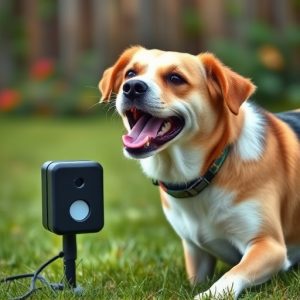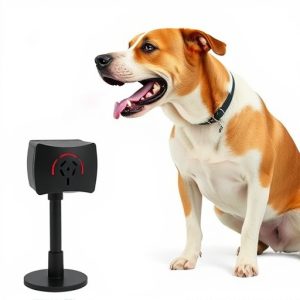Ultrasonic Behavior Modifiers: Humane Training with Electronic Repellents
Dogs respond best to gentle training methods. Humane Training Modes using ultrasonic repellents offe…….
Dogs respond best to gentle training methods. Humane Training Modes using ultrasonic repellents offer a non-punitive, effective approach by emitting inaudible sounds to discourage unwanted behaviors like barking or jumping. These tools promote positive associations and faster learning, fostering stronger bonds between dogs and owners while emphasizing kind training practices.
“Unleash a well-behaved companion with the power of humane training techniques! This comprehensive guide explores an innovative approach to dog training using ultrasonic behavior modifiers. By understanding canine behavior and leveraging the science behind electronic repellents, we reveal effective strategies for positive reinforcement.
Discover how these gentle methods transform training sessions while ensuring your furry friend’s comfort. From addressing common behavioral issues to achieving desired actions, learn the best practices for implementing humane training modes with success stories highlighting their impact.”
- Understanding Dog Behavior and Ultrasonic Repellents: A Gentle Approach
- The Science Behind Electronic Repellents for Dogs
- Implementing Humane Training Modes: Tips and Best Practices
- Success Stories: How Ultrasonic Behavior Modifiers Have Transformed Canine Training
Understanding Dog Behavior and Ultrasonic Repellents: A Gentle Approach
Dogs, much like humans, have unique personalities and respond differently to various training methods. Understanding their behavior is crucial for effective and humane training modes. Positive reinforcement, including rewards and praise, has long been recognized as a gentle yet powerful tool to teach desired behaviors.
Ultrasonic repelents are another innovative approach, employing electronic repellents that emit high-frequency sound waves invisible to the human eye but unpleasant to dogs. These devices can be particularly useful for modifying unwanted behaviors like barking or jumping without resorting to traditional, potentially stressful methods. They offer a non-confrontational way to guide canine behavior, making them a popular choice among dog owners seeking humane training options.
The Science Behind Electronic Repellents for Dogs
The science behind electronic repellents for dogs has evolved significantly, offering humane training modes that stimulate specific behaviors without causing harm or fear. These devices utilize ultrasonic sounds, which are high-frequency acoustic waves that humans can’t detect but dogs can. When a dog exhibits undesirable behavior, like jumping on furniture or barking excessively, the trainer activates the electronic repellent. The device emits a high-pitched sound that is unpleasant to dogs but safe for their sensitive hearing. This prompt serves as a positive reinforcement for good behavior, teaching the dog what actions are acceptable and which ones result in the ultrasonic deterrent.
Compared to traditional training methods that often rely on negative reinforcements or punishment, electronic repellents provide a more gentle approach. They’re particularly effective for addressing specific behaviors like aggression, territorial barking, or excessive jumping. The technology is designed to be sensitive, activating only when the dog is displaying the targeted behavior, ensuring minimal discomfort and promoting positive learning experiences. This humane training mode encourages dogs to respond to cues based on positive associations rather than fear or pain.
Implementing Humane Training Modes: Tips and Best Practices
When implementing humane training modes with an electronic repellent, it’s essential to prioritize your dog’s well-being and use methods that are kind and effective. Start by identifying specific behaviors you want to modify, such as excessive barking or jumping on guests, and understand why they occur. Positive reinforcement is a powerful tool; reward desired behavior with treats and praise, and avoid punishing unwanted actions, as this can create fear or anxiety.
Use the electronic repellent as a gentle guide, triggering only when necessary. Set it to a low sensitivity level initially and adjust as your dog learns. Always supervise training sessions and ensure your dog has sufficient exercise and mental stimulation to prevent boredom or stress. Regular, consistent practice in short bursts is key; break down training into manageable steps and celebrate small victories to foster a positive learning environment.
Success Stories: How Ultrasonic Behavior Modifiers Have Transformed Canine Training
Ultrasonic behavior modifiers have emerged as a game-changer in canine training, offering humane training modes that use electronic repellents to shape desired behaviors. These devices emit high-frequency sound waves that are inaudible to humans but can be detected by dogs. When a dog exhibits unwanted behavior, the modifier emits a quiet, subtle tone that serves as an instant correction without causing physical harm or discomfort.
Success stories from dog trainers and owners across the globe attest to the effectiveness of these tools. Many have reported significant improvements in their dogs’ behavior, including reduced barking, improved focus during training sessions, and better overall obedience. By providing immediate feedback, ultrasonic behavior modifiers enable trainers to teach new commands and behaviors more efficiently, fostering stronger bonds between humans and their canine companions while promoting positive reinforcement techniques.
Dog training can be a rewarding process, and incorporating humane training modes like electronic repellents offers a gentle yet effective solution for modifying canine behavior. By understanding dog behavior and leveraging the science behind electronic repellents, owners can successfully train their pets while maintaining a positive, compassionate approach. These ultrasonic behavior modifiers provide a safe and non-violent way to guide dogs, as evidenced by numerous success stories of transformed training experiences. Adopting humane training modes not only enhances the bond between dog and owner but also contributes to the overall well-being and happiness of our furry friends.


